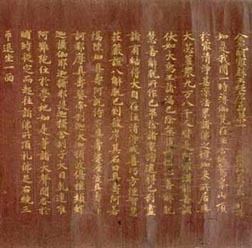 | ||
Similar Irk Bitig, Longer Sukhāvatīvyūha Sūtra, Mahāyāna Mahāparinirvāṇa Sūtra, Lankavatara sutra, Vimalakirti Sutra | ||
Lama zopa rinpoche full oral transmission of golden light sutra all 21 chapters
The Golden Light Sutra or Suvarṇaprabhā Sūtra (Sanskrit: सुवर्णप्रभासोत्तमसूत्रेन्द्रराज, IAST: Suvarṇaprabhāsottamasūtrendrarājaḥ), also known by the Old Uygur title Altun Yaruq, is a Buddhist text of the Mahayana branch of Buddhism. In Sanskrit, the full title is The Sovereign King of Sutras, the Sublime Golden Light.
Contents
- Lama zopa rinpoche full oral transmission of golden light sutra all 21 chapters
- Preamble
- History
- Translations
- Chinese Translations
- Japanese Translations
- Translations into Western languages
- References
Preamble
History
The sutra was originally written in India in Sanskrit and was translated several times into Chinese by Dharmakṣema and others, and later translated into Tibetan and other languages. Johannes Nobel published Sanskrit and Tibetan editions of the text. The sutra is an extremely important Mahayana sutra, and one of the most popular Mahayana sutras of all time.
The name of the sutra derives from the chapter called "The Confession of the Golden Drum", where the bodhisattva Ruchiraketu dreams of a great drum that radiates a sublime golden light, symbolizing the dharma or teachings of Gautama Buddha.
The Golden Light Sutra became one of the most important sutras in Japan because of its fundamental message, which teaches that the Four Heavenly Kings (Chinese: 四大天王; pinyin: Sì Dàtiānwáng) protect the ruler who governs his country in the proper manner.
The sutra also expounds the vows of the goddesses Sarasvatī (Chinese: 大辨才天; pinyin: dà biàn cái tiān), Lakṣmī (Chinese: 大功德天; pinyin: dà gōng dé tiān) and Dṛḍhā to protect any bhikṣu who will uphold and teach the sutra.
Taken at face value, one might take the main theme of the sutra literally, which is the importance for leaders to be good examples for the kingdom. In Chapter Twelve, the sutra speaks in verse form about the disasters that befall a kingdom when its ruler does not uphold justice, and the benefits of kings who lead an exemplary life. In the Chapter on the Guardian Kings, the Four Guardian Kings have a dialogue with the Buddha, explaining in vivid detail all the benefits a kingdom will have if its ruler enshrines the essence of the sutra and offers daily praise. The sutra contains some elements of early tantra, in that in chapter two, the sutra describes four Buddhas who dwell in the four cardinal directions. These same four comprise later Buddhist mandalas in the same positions, such as the Womb Realm.
Hence, historically the sutra won great esteem as a sutra for protecting the country, and often was read publicly to ward off threats. Its first reading as a court ceremony was around 660 AD, when the Tang dynasty of China and Silla of Korea defeated the state of Baekje of Korea and were threatening Japan.
In 741 Emperor Shōmu of Japan founded provincial monasteries for monks (国分寺) and nuns 国分尼寺) in each province. The official name of the monasteries was the Temple for Protection of the State by the Four Heavenly Kings Golden Light Sutra (traditional Chinese: 金光明經四天王護国之寺). The 20 monks who lived there recited the Sovereign Kings Golden Light Sutra on a fixed schedule to protect the country. As Buddhism evolved in Japan, the practice gradually fell out of use, and is no longer continued today.
Translations
The Golden Light Sutra has been translated into Chinese, Saka ("Khotanese"), Old Turkic, Old Uyghur, Tangut, Classical Tibetan, Mongolian, Manchu, Korean and Japanese.
Chinese Translations
Three canonical Chinese translations have survived:
An extracanonical version, ascribed to Paramārtha (499-569) is extant in a Japanese manuscript.
Japanese Translations
One of the earliest Japanese annotations was an 8th century kunten translation of the Yijing Chinese translation housed in Saidaiji Temple.
In 1934, Ama published a complete translation directly from Sanskrit.
Translations into Western languages
Some translations into Western languages exist from Sanskrit and Tibetan, but there are no known translations from other languages such as Chinese, Japanese, Korean, or Mongolian.
In 1970, Emmerick produced an English translation of the short, condensed Sanskrit version of the Sutra of Golden Light into English.
In Tibetan, there are three versions of the Sutra: the 21, 29, and 31 chapter versions. The 29 Chapter Version was probably the most popular in Tibet and Tibetan Buddhist regions.
In 2007, the Foundation for the Preservation of the Mahayana Tradition, Lama Zopa Rinpoche's Buddhist organization, produced a translation of the 21 chapter version of the Sutra, the most abbreviated and condensed version.
